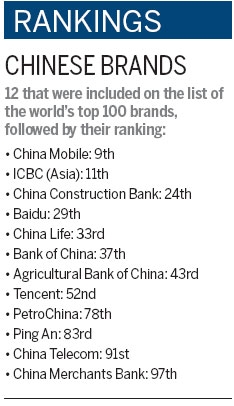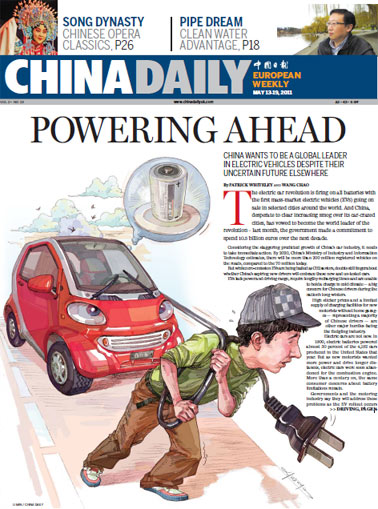The global rise of Chinese brands
Updated: 2011-05-13 10:58
By Mike Bastin (China Daily European Weekly)
 |
The annual BrandZ survey, which aims to identify the world's top 100 brands, has just been released for 2011 with an impressive, but not unexpected, showing by major Chinese brands.
|
 |
Of these leading Chinese global brands, two are most definitely deserving of extra special praise: ICBC, now the No 1 global financial institution brand valued at $44.4 billion (30.8 billion euros); and China Life Insurance, now the No 1 global insurance brand with a value of $19.5 billion. In addition, China Life is the 5th highest newcomer to this year's rankings.
Overall, 12 Chinese brands made it into the world's top 100 most valuable brands. But most telling is the fact that almost half of the 11 newcomers to the list were also Chinese companies. The five Chinese new entrants include China Life (insurance), ranked 33rd; Agricultural Bank of China, ranked 43rd; Tencent (China's largest Internet service portal), ranked 52nd; Ping An (insurance) ranked 83rd; and China Telecom, ranked 91st.
While not in the overall top 100, another noteworthy performance was achieved by MetersBonwe, China's largest casual clothing company now ranked the 10th most valuable global clothing brand. This has been achieved with little or no international expansion as yet. Metersbonwe, which opened its first store in Wenzhou in 1995, targets 18- to 25-year-old male and female consumers and builds its brand identity with the corporate slogan "Be Different".
Over the next few years it will come as no surprise if this brand competes more aggressively, and successfully, with the likes of Nike, domestically and internationally. This is representative of a new breed of Chinese company, consisting of an abundance of talent, knowledge, innovation and ambition.
The rise of Chinese brands is even more spectacular when compared with other developing nations. For example, only one Indian company can be found in the top 100, India's ICICI Bank, and just four Brazilian companies/brands, Petrobras (oil producer) Brahma and Skol (beer), and Natura (personal care) are in it.
Perhaps China's Baidu and Tencent brands deserve particular praise and can be representative of a broader surge among Chinese brands. In this year's rankings, Baidu captured 29th spot, up from 75th in 2009 with a spectacular 141 percent rise in brand value. As more of China's 1.3 billion citizens searched the Internet, it appears that they chose Baidu due to the fact that the brand has been built on an encyclopedic understanding of the nuances of China's diverse cultures and languages.
Tencent's ranking (52nd) can be interpreted as meteoric given that the company has only been in existence since late 1998. Tencent QQ, generally abbreviated to just QQ, is the most popular free instant messaging service across the Chinese mainland and boasts about 700 million user accounts. Impressively, the number of simultaneous online QQ accounts exceeded 100 million in early February. Since its entrance into Chinese households, QQ has rapidly emerged as a modern cultural phenomenon.
In addition to the rise of the Chinese brand, another clear trend that continues to emerge from this year's findings is the prominence of technology brands. Apple now occupies the much coveted No 1 spot, beating Google into 2nd. Furthermore, four of the top five positions are now taken by technology brands with IBM 3rd and Microsoft 5th. Further illustration of change is evident from Amazon's rise to 14th in the overall rankings, eclipsing Walmart (ranked 15th) as the most valuable retail brand.
Understanding and even anticipating change in consumer behavior and lifestyles will always be at the heart of long-term brand success and such an insight cannot be bettered by Apple. Until recently, few appreciated the dearth of a digital gadget smaller than their laptop but larger than their mobile phone. However, by the end of 2010, around 18 million people were proud owners of iPads or other similar tablets.
Apple realized that its customers value access to data and images anywhere, anytime, in easy-to-view definition with an easy-to-use touch interface. In a development time of only a few months, the company met these needs with the iPad and iPhone 4 brands.
Apple perceived that its customers would discover uses for these products that will help organize, simplify and improve their lives.
Tracking brands
Developed by Millward Brown, the London-based market research agency, the BrandZ Top 100 Most Valuable Global Brands ranking analyzes the world's leading brands and the economic and competitive dynamics that influence value fluctuations. It is the most comprehensive annual ranking of brand value, and focuses on consumer-facing brands, rather than corporate brands.
In order to appreciate the importance of these survey findings, it is worth exploring the methodology undertaken a little further. This not only verifies credibility in the survey findings, it also enables invaluable insight into the determinants of brand building success.
Unlike the other approaches, which mainly focus on large brands, the BrandZ methodology works well for brands of all sizes, big and small, especially lower profile brands. It is based on a combination of historical financial data as well as consumer studies. The basis of this approach has been termed "voltage", which refers to a brand's potential to increase its market share in the future. At the heart of "voltage" is a five-level pyramid based on bonding, advantage, performance, relevance and presence and the share of wallet; all of which are measured on a scale from strong to weak in order to gain an understanding of the brand's worth.
Consumer perceptions are the key input into the "voltage rankings". Here, the brand's relationship with its market can be mapped as a pyramid. The bottom layer is "awareness" or the proportion of consumers with an active knowledge of the brand.
The second layer is "relevance" which focuses on the ability of the brand to meet a consumer's specific needs.
Next comes "performance," and this dimension demands an answer to the following: Does the brand meet or exceed the category standards as well as the ability to deliver the brand owner's promised experience? Moving further up the pyramid is "advantage", and this aims to assess the market's perception that the brand has some differential advantage (either tangible and/or intangible) over its competitors such as pricing (tangible) or product innovation (tangible) or fashion (intangible). Finally at the top of the pyramid is "bonding", which refers to some unique advantage for individual customers that forms the best relationship to the brand and therefore has the best voltage ranking.
In short, "voltage" represents real competitive advantage and a summary of the growth potential of the brand. It takes into account how many people are very loyal to the brand (the brand's bonding score) and the claimed purchasing data for the category to produce that single brand voltage number. A brand with a positive (+) voltage score has the potential to gain share from its own marketing actions and to resist the actions of competitors. Brands with a negative (-) voltage score can still grow, but will have to work harder and will be more vulnerable to the actions of other brands.
In the BrandZ study there is a also ranking of eight brand typologies:
Clean Slate: Little known to most consumers (Xiao Hong Mao).
Little Tiger: Relatively unknown but with strong following within a core group (Qingfeng Baozi).
Cult Brand: Not widely known and not for everyone but has attained a fanatical following (Starbucks).
Aspirational: Well-known but not suitable for a mass audience. Maybe too expensive (Tommy Hilfiger).
Classic: Well-known, well-loved with a relatively large core following (Budweiser).
Olympic: Well-known, well-loved and a large core following (Walmart).
Defenders: Good balance between product performance and price but not real product-based or emotionally rooted advantages (Fila).
Fading Star: Previously known and universally liked and still relevant to a mass audience, but has lost some appeal and has little product- or image-based advantage (7-Eleven).
Consumer culture
Let's not forget that consumers drive brand success, which requires all brand managers to gain ever deeper knowledge and understanding of consumer culture. This survey most definitely adds to this insight and the following four trends in consumer culture development can be discerned from the positions of the most successful brands:
Assertion of individuality: A surge of personal expression, empowered by the Internet, also appears to have been matched by consumer preference for personal expression in apparel and other products, resulting in a trend toward the bespoke brand (for those who could afford it) or mass customization (for everyone else).
Concern for personal health and wellbeing: Consumers across economic groups appear to be paying more attention to the food they put in their bodies (hence improvements in fast-food menus) and the products they put on their bodies (changes in personal-care ingredients).
Concern about the environment: While consumers appear cautious when asked to pay any price for environmentally friendly products, being "green" appears to have become an important hygiene factor in some categories (e.g. the introduction of more hybrid and some electric cars).
Concern about product provenance: Consumers increasingly want to feel good about their possessions.
The author is visiting professor of brand management at China Agricultural University and teaches marketing and management at Tsinghua University.
E-paper

War of the roses
European Chinese rose growers are beating their Chinese rivals at their own game
Preview of the coming issue
High-tech park gets big boost
At the source
Specials

New wave
Coastal city banks on marine sector to ride next stage of economic development

Drunk driving
Drunk drivers face a detention for one to six months and a revokation of their drivers' license.

V-Day parade
A military parade marking the 66th anniversary of the Soviet victory over Nazi.
